-
Posts
6,486 -
Joined
-
Last visited
-
Days Won
10
Content Type
Profiles
Forums
Blogs
Gallery
Events
Store
Posts posted by Brian Wolfe
-
-
Thanks fellows.
Pakistan and even Indian modern military history seems to be purposly hidden from the world view.
I know we will all keep digging for more information.
Regards
Brian
0 -
A very nice find along with the research results makes this an excellent addition, well done Paul.
Regards
Brian
0 -
A surplus store find? That's it, I'm moving to Aberta!
Well done.
Regards
Brian
0 -
Very nice.
Regards
Brian
0 -
Interesting and interested.
Thanks Mike.
Regards
Brian
0 -
I'll add my two cents worth and agree.
The badge on these, and I've seen a few in my time, are always in better condition.
In my opinion the bugle would have been better off with no badge at all.
Sorry to have to agree with bad news.
Regards
Brian
0 -
Hi Chris,
Your post has triggered a memory of back in the days when I was seriously interested in paleontology and geology. We used to mark specimens with a small dab of white acrylic paint (titanium white I believe) and once dry a number would be written on with a straight pen dipped in India Black ink. This was sometimes covered with clear finger nail polish. This can be removed with nail polish remover if needed. This paint comes in tubes and is sold at artists supply stores.
My question to you is whether something like this could be done on the backs of the EKI with the recipients name and other information. Failing this perhaps a type of tape could be employed instead and used for the same purpose. The smooth back of the EKI should allow for easy removal if needed.
You could test it out on one of your wifes kitchen knives to see if it would work for you, and also test if it could be removed easily enough. If it fails your expectations you have the option of throwing the knife out and tell the missus that it was probably tossed out with the garbage while cleaning off a plate. It happens.
If this sounds like a crazy idea then perhaps it will start you thinking about other alternatives; about the information on the back of the EKI not about explaining the missing knife, youre on your own with that.
Regards
Brian
0 -
I agree that if France had withdrawn from the War the British would have had no choice other than to also withdraw. The line of defense was too long for one of the Allies to hold and the loss of France would have left huge gaps for the Germans to exploit. I think, given time, the colonial forces may have filled the gaps, thinking that the Indian Army had not been used as efficiently as possible. However I doubt there would have been time to re-think the whole thing.
Here the First World War is seen as a British/German thing by many of the public with a few Frenchmen thrown in for good measure. Of course the facts do not support that misconception.
The War was started by Russia declairing war on Austria, then Germany supported Austria, France supported her ally, Russia, and the British threw in with France. It would probably be more accurate to see it as a Russian/Austrian conflict or even a French/German war that drew in the rest of the world.
The one thing we can all agree on is that it was a blood bath. It makes me wonder if the "old Gods" are not still with us and getting their blood sacrifice though the stupidity of mankind rather than from the old religious rituals.
Regards
Brian
0 -
With all due respect Ulsterman, are we talking about the same war? From what I have read the German fleet had been pretty well defeated at the Battle of Jutland, or at least bottled up.
Both sides were at the point of exhaustion and I woud conced that one side would have won over the other but I think it would have led to peace talks by 1919. I'm not basing this on books and other's fine and indisputable research but from conversations with WWI Veterans from both sides. To quote an old Prussian soldier I knew well and hunted with for many years, "We had cabbages and carrots, cabbages and carrots; I got to hate those cabbages and carrots. By the end of the war we would have welcomed either cabbages or carrots but got little to eat". The allies still had resources from her Empires such as Canada and the U.S.A. would have still been what could be construed as war profiteering even if sales of material had to be done on credit. Perhaps if America had not joined the war, (this is where I am obligated to state my "thanks be to God for America"), and German had still lost, the U.S.A would have owned all of Europe through the financial debt owed to them.
I won't get drawn into a long debate on this because I fear it would only make me appear to be anti-American, which is something I am anything but.
Regards
Brian
0 -
Thanks Larry.
Regards
Brian
0 -
I have held the above opinon for a long time and research supports it. America shortened the War drastically however my opinion in no way deminishes their contributions.
Regards
Brian
0 -
Very nice start, and with that the obsession started.

Well done and thanks for posting them.
Regards
Brian
0 -
Thank you Michael, and it is obvious as to why it would have been dropped by 1971.
It is these small details that are clues to the history that many never realize.
Yet one more benifit of belonging to the GMIC (shamless promotion).

Regards
Brian
0 -
Pakistan’s Combat Stars and War Medals
Pakistan and India fought two major wars, one in 1965 and another in 1971. These were not long and drawn out affairs though the seeds of the conflicts had been sown decades before; I will not get into those here. It would be simplifying the causes of the wars to say that they were merely ideological differences (Islam verses Hindu). However these differences certainly could be cited as the reason the fighting on both sides was so intense.
India gained independence in 1947 and simultaneously Pakistan formed its own independent state resulting in what is known as “Partition”. The two countries were never on good terms and border disagreements were bound to erupt. In 1965 India and Pakistan went to war over such a boundary dispute in the Region of Kashmir. The War was fought from April to September of 1965 and while, as stated, the War was not a protracted one it did generate a good number of military casualties. India suffered 3,000 KIA while Pakistan sustained 3,800 KIA.
In 1971 India supported East Pakistan (now Bangladesh) during the East Pakistan Liberation War. Fighting between the forces of the then West Pakistan and India broke out on India’s Eastern border in what is called the world’s shortest war; lasting from December 3rd to 16th. Even though the war was restricted to such a short time span it generated 194 KIA for India while Pakistan was 1,900 KIA. Civilian losses for both of the above wars are not figured into the totals.
The 1965 War generated the first of Pakistan’s two Combat Stars and accompanying War Medals. To clarify, the Combat Star was awarded to those actually serving in an area of combat activity while the War Medal was awarded to those who were serving anywhere during the conflict. The combat star is always accompanied by the war medal for the particular war they were awarded for. However the war medal can be found in groups alone.

In the case of the 1965 combat star you will find most of these officially named on the reverse. The war medals were not named for either war unless it was undertaken privately.

The 1971 War produced another pair of these combat stars and war medals. The combat star in this case is never officially named as is the war medal and again neither was the 1971 war medal.
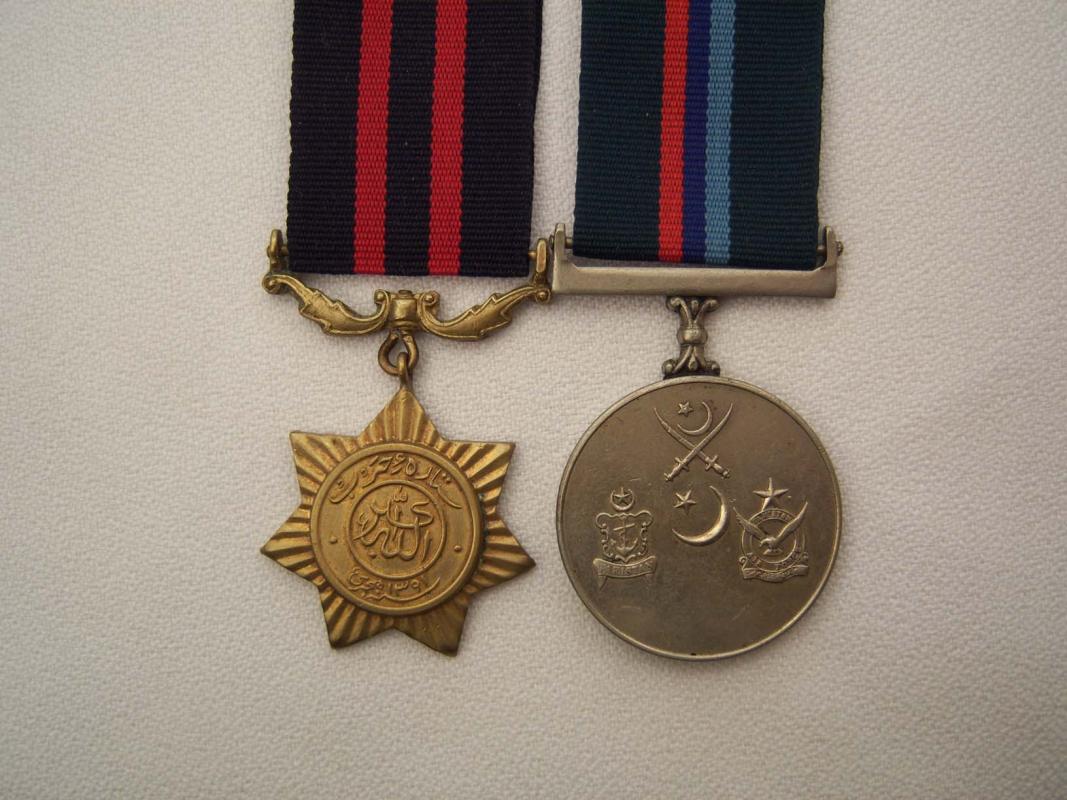
As has been said many times, there is always an exception to any rule. In this case the 1971 War medal shown the recipient had his medal privately (unofficially) named.
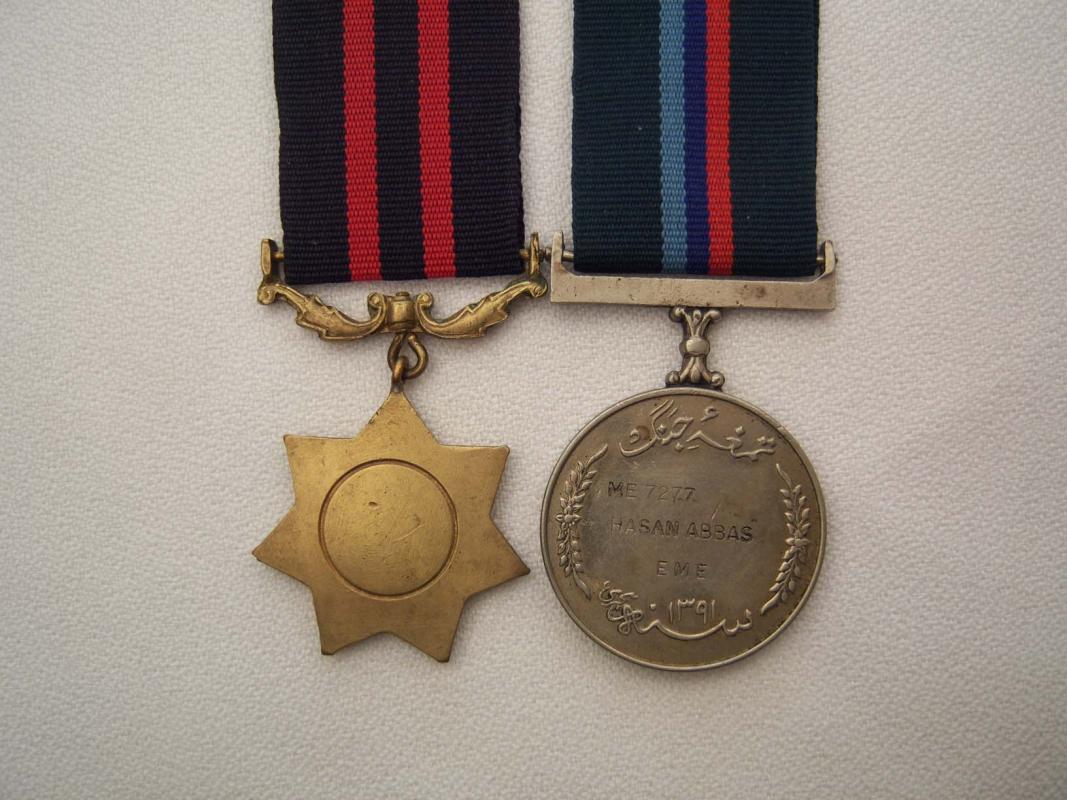
The Sitara-i-Harb 1965 and 1971 (combat stars)
The correct names of the combat stars is, the Sitara-i-Harb 1965 and the Sitara-i-Harb 1971. At a resent show I attended I overheard a dealer tell a customer that the only difference between the two was the different ribbons. For me this was one of those jaw dropping moments brought on by an overwhelming feeling of disbelief in that statement.
True they both have ribbons with a black field with the 1965 star having one red stripe while the 1971 star sports two red stripes. Beyond differences in the red strips on a black field and that they are both stars there is a world of difference, at least to the educated collector. The medal suspension bars differ as does the method of affixing the star to the bar. The 1965 star is suspended so that two points of the star are horizontal while the 1971 is suspended by the tip of the star’s point.
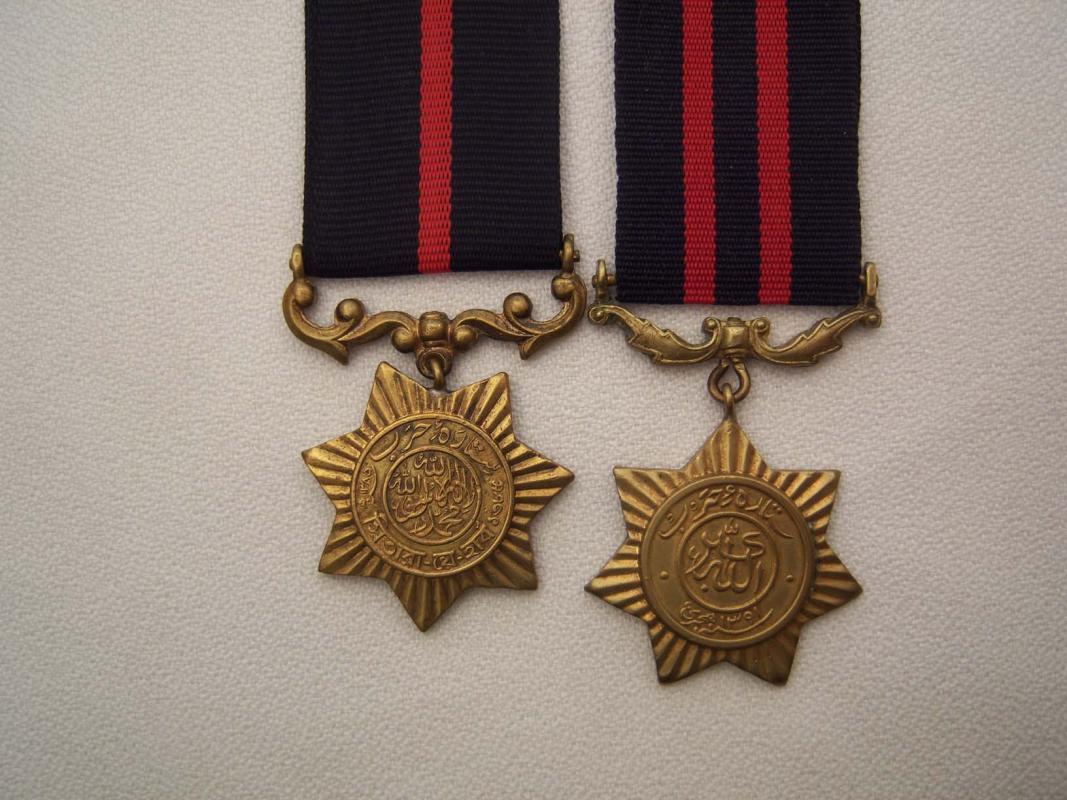
We have already discussed that the reverse of the 1965 star was officially named while the 1971 was not. That’s seems easy enough but let’s take a look at the obverse of the two stars. While I cannot translate the writing one can plainly see there is a vast difference.
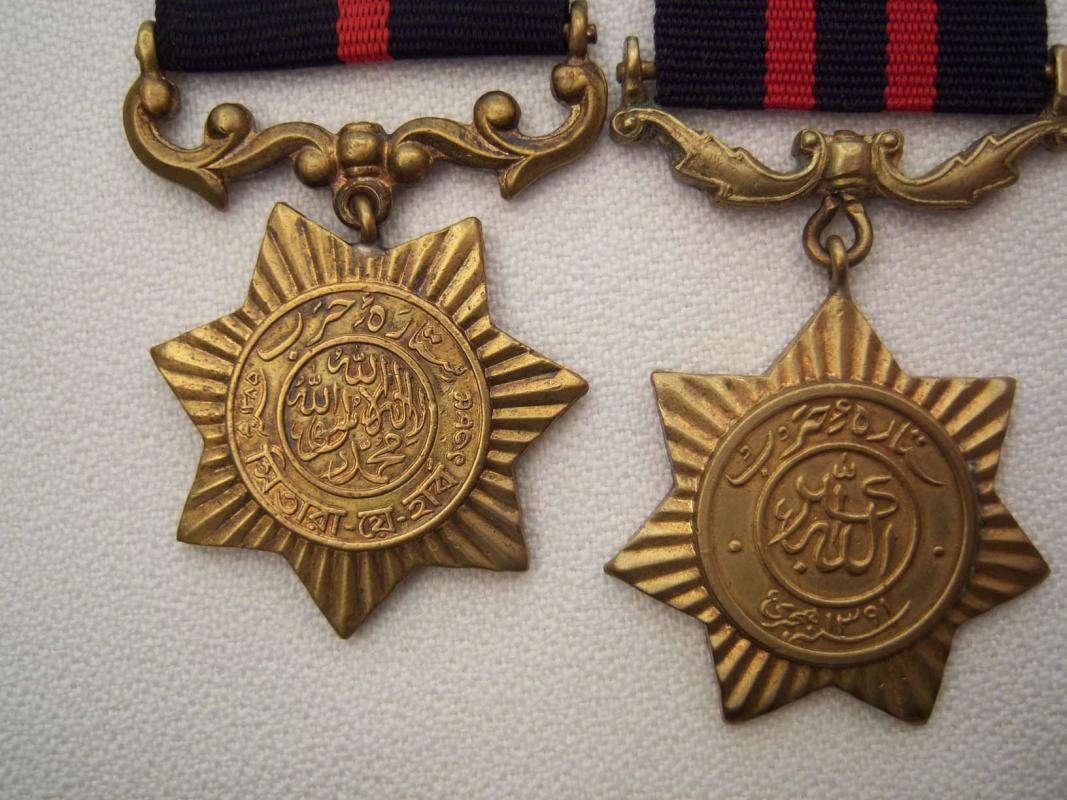
The Tamgha-i-Jang 1965and 1971 (War Medals)
The obverse of the 1965 and 1971 war medals is virtually identical so when viewed in a group, especially when the combat star is absent, the difference in this case is indeed the ribbons.
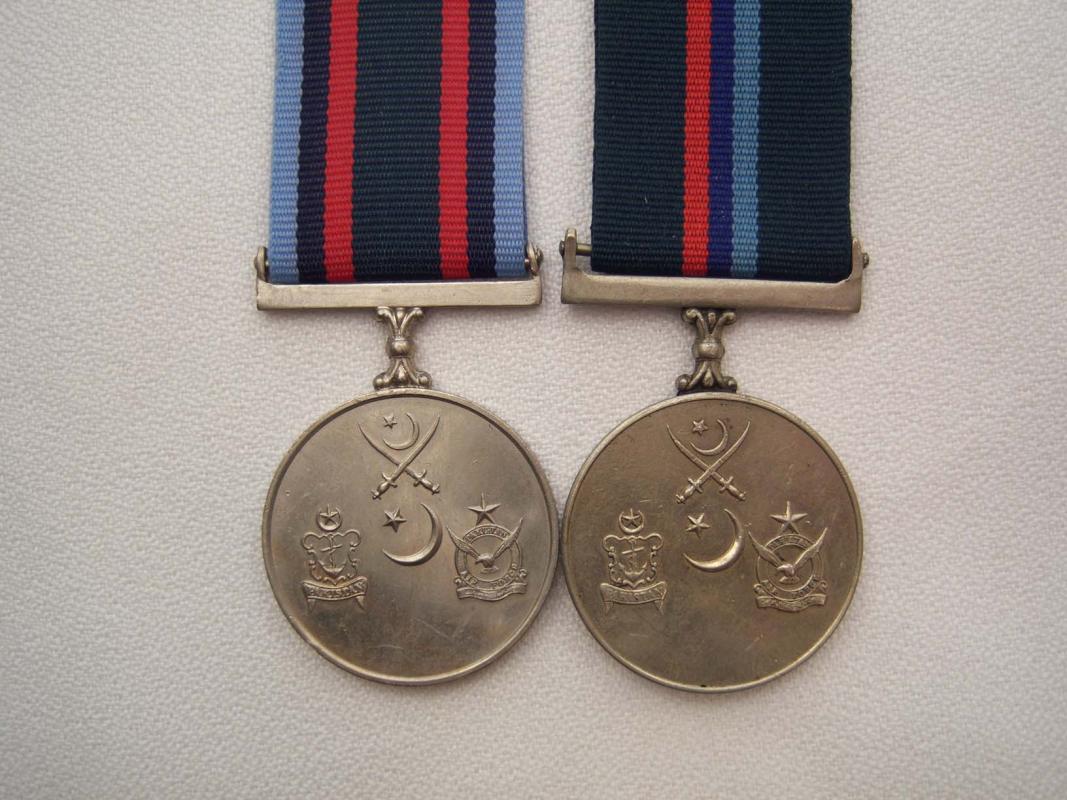
There is a vast difference when it comes to the reverses however. The 1965 has script in the center surrounded by script around the outer edge. However the centre of the 1971 is blank with the date written at the bottom. If you look closely at the 1965 I believe the script at the bottom is in Hindi while the balance of the script is possibly Urdu, Islamic or Arabic calligraphy. I apologize for my lack of knowledge in this area. The 1971 war star is missing the Hindi. As may be noted in the examples below the recipient of the 1971 medal has utilized the blank space to have the medal unofficially named, English lettering.
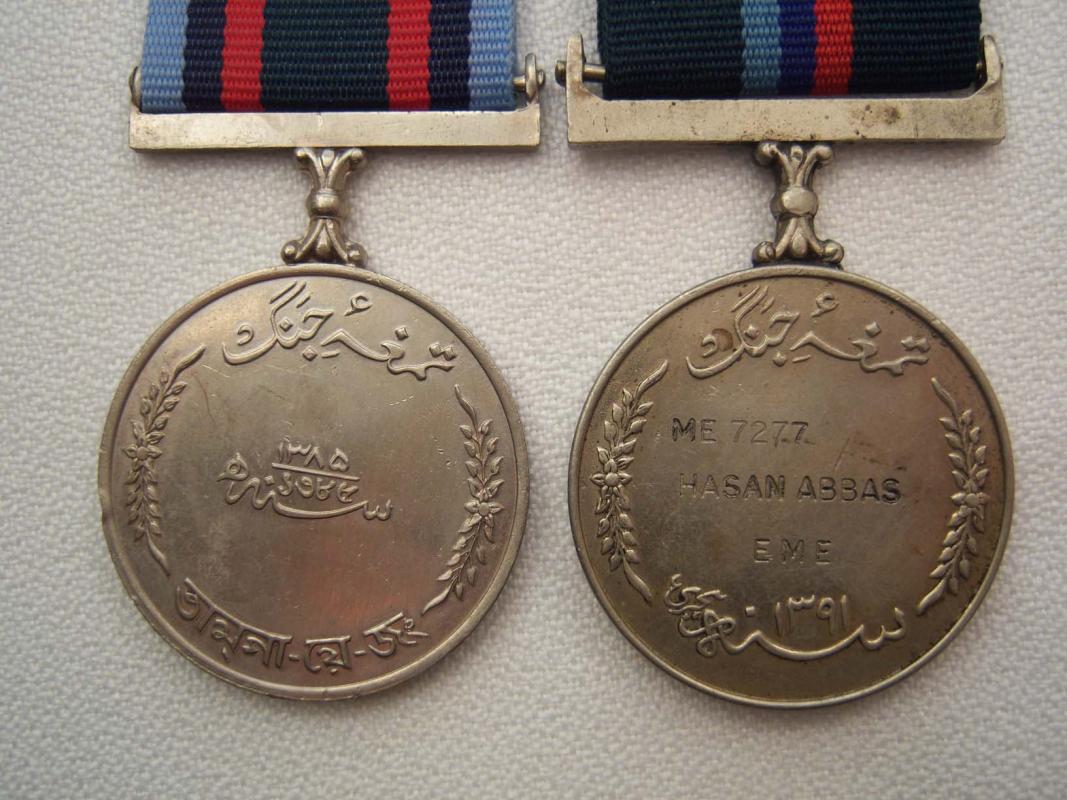
As mentioned above the star and the medal for each war are found either in pairs or within groups of medals. The medal can be found by itself in a group but the star is always, or should always be accompanied by the circular medal.
The first example of a group containing a medal without its star is shown below. The star and medal are for the 1971 War yet the recipient was serving during the 1965 War yet NOT within a combat zone, therefore the medal appears alone.
The reason for the seemingly missing Hijri Tamgha Medal (Gold ribbon with Black stripe) is that often we see this when the recipient had yet to actually receive the medal yet needs to show the place on the medal bar. This is quite common with Indian Medals as well.
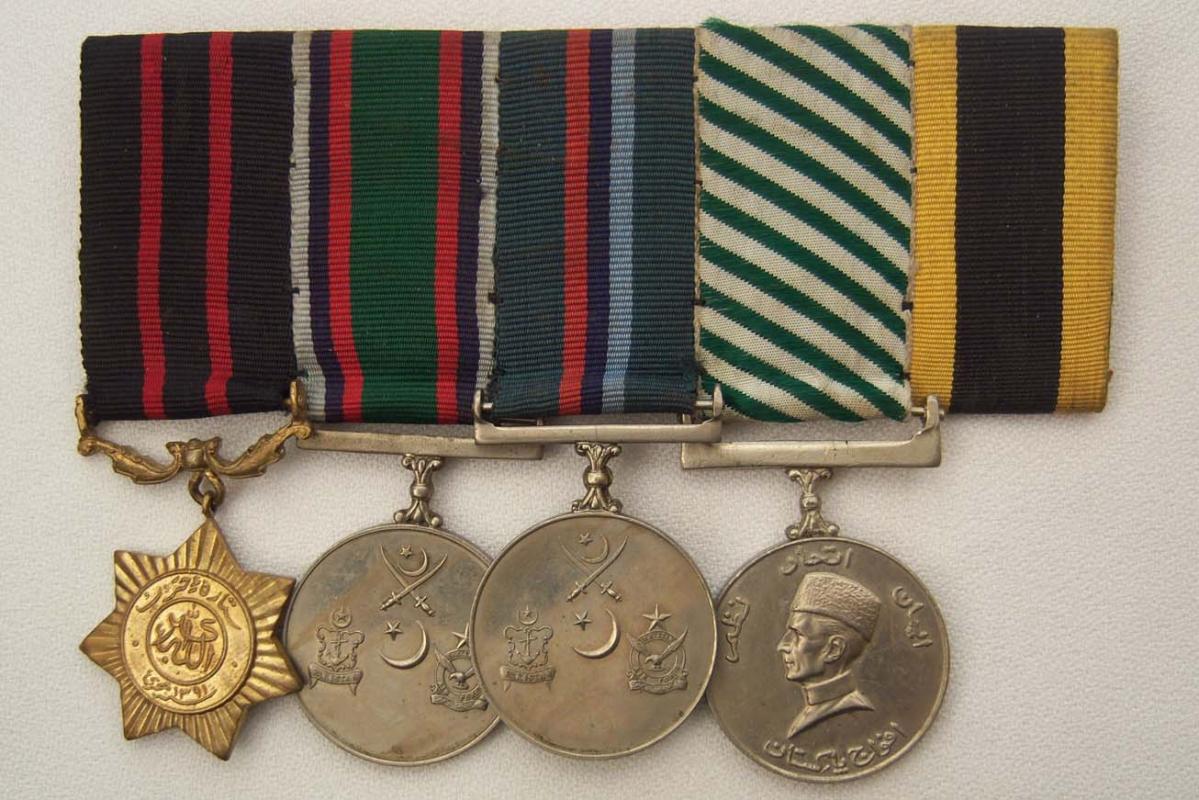
The last example is of a very nice original group showing both 1965 and 1971 combat stars and their accompanying war medals. This group has quite the personal attachment for me. My brother and his wife were visiting her family in China one year. He had offered to keep watch for Chinese medals while there and I asked him not to due to the many fakes that abound. In our conversation I mentioned that I collected Indian and Pakistan medals. A street vender had this group of medals off to the side. I should call them a “glob” of medals as they were strung together on a wire so I had to mount them. My sister-in-law speaks the official language of Chinese street venders’; it’s called “negotiation” which led my brother to later confess that he only had to pay the equivalent of $5.00 American for the whole group.
For those who have yet not noticed the Tamgha –i- Jang 1971 is mounted with the ribbon on backwards. Oops.
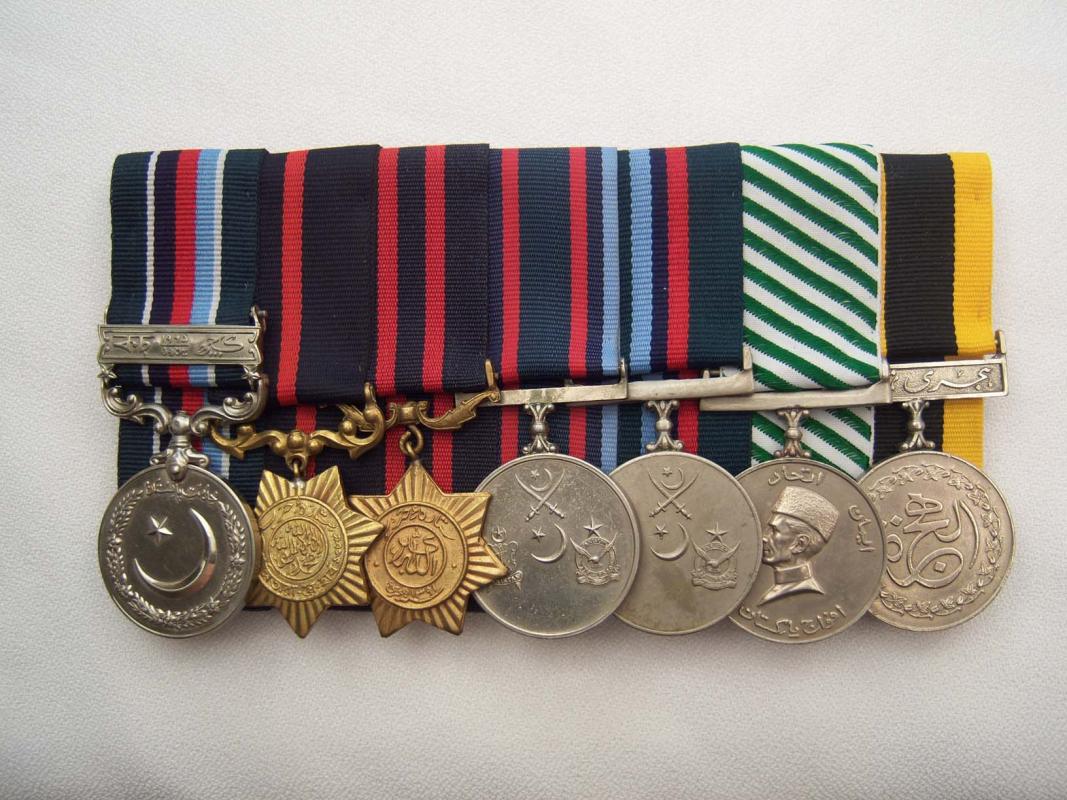
Regards
Brian
0 -
Police Lanterns and the Comic Post Card
One of the favourite targets of publications such as Punch, among many others, was the London and Metropolitan Police almost from the first day they were formed. One of these mediums of satire, or humour, is the countless number of post cards that were available to the public at that time. The first example is not as crewel as many and simply uses a double meaning of the statement “I see I’m in time”. Considering the minimal “background” light, compared with what we experience today from electrical street lights and illuminated signs, the low light level of the old lantern was probably as bright as shown in this post card.
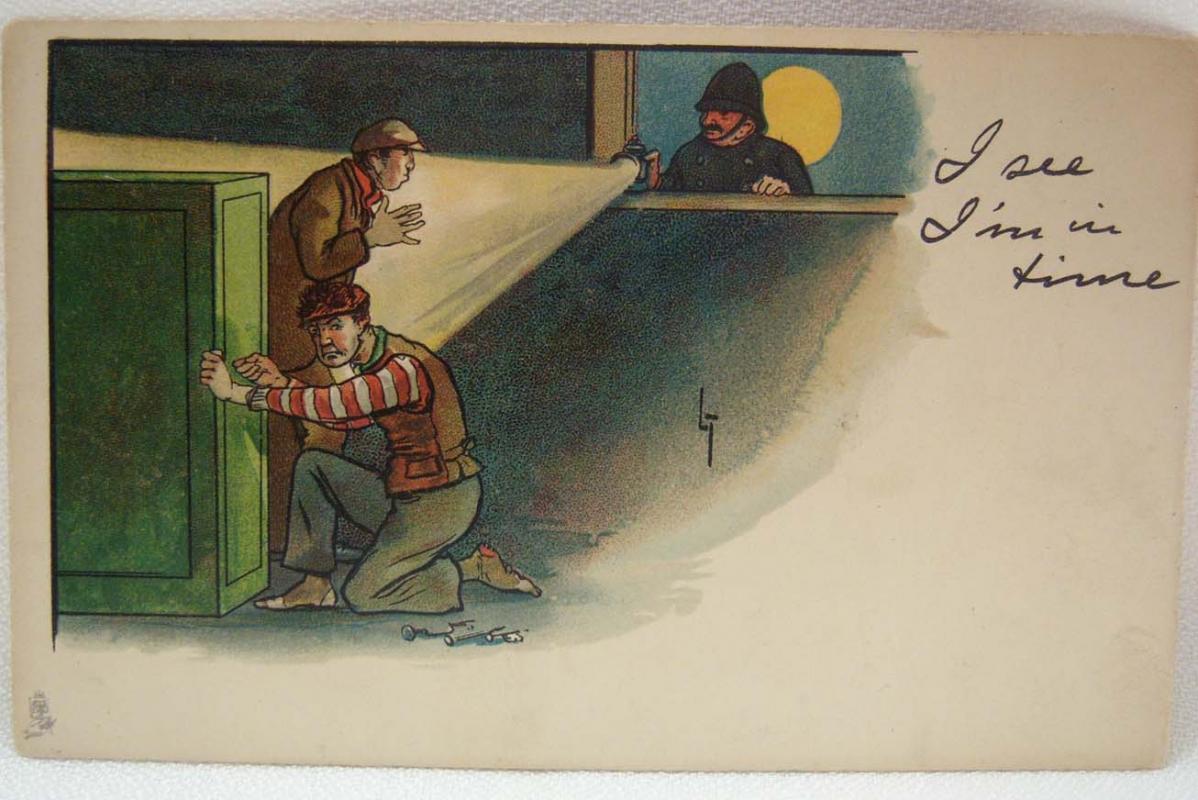
Of the humorous post cards that are offered for sale to the collector today I think the ones having a “go” at the Special Constables is the most prolific. However, we’ll stay with the PC and leave the SC topic to its proper section. The two examples below concerns what is probably the most common “adventure” the police runs into, even today. A couple out on their own confronting a police constable; who hasn’t had this happen to them?

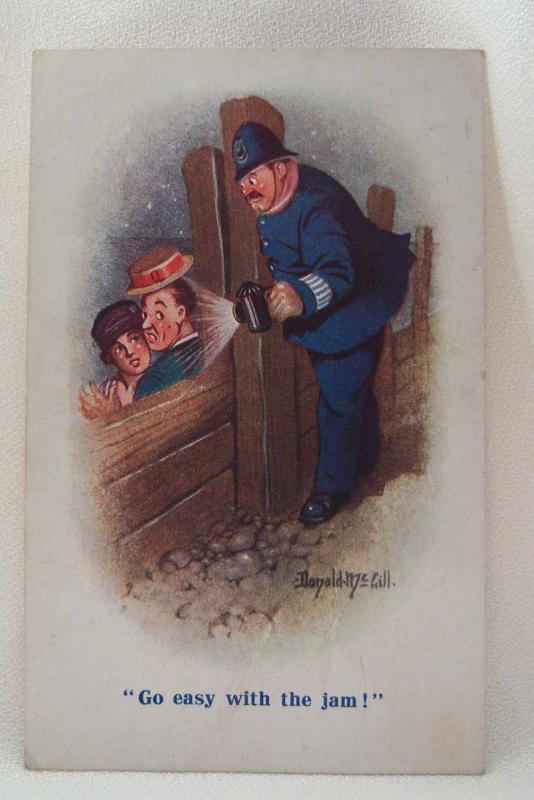
Next we’ll take a look at some early battery powered “torches”, or as known on this side of the pond, “flashlights”.
In the mean time, if you have any post cards or illustrations involving the British Police please feel free to post them here. I’ll wait for a couple of weeks before I proceed with the next installment of this post to give you time to post them.
Regards
Brian
0 -
Hi Dave,
Good eyes, I can see it now but even so only because you could read it, so I'm using some imagination along with my old eyes.

Thanks very much for the additional information, I will be sure to record it for other near-sighted collectors of the future.
Regards
Brian
0 -
Great weapons, thanks for posting them.
Regards
Brian
0 -
A beautiful sword indeed, Thanks for posting it.
Regards
Brian
0 -
While there are a lot of reproductions on the market today I do like what I am seeing.
Nice piece.
Regards
Brian
0 -
Thanks for that information Mike and thanks too for your attached photo.
I believe you started a post a while back on these but darned if I could find it; I was intending to use my post in the form of a reply to yours.
Sometimes there is just so much information to sift through that posts seem "lost", even with the search option.
Thanks again.
Regards
Brian
0 -
Cadbury Brothers
A short while ago a friend and I were talking about different periods in history and what had taken place. My friend is an intellectual fellow and well read so conversations with him are anything but trite. Something that he brought up and a subject that has been on my mind for some time as well is how do we know what we read as historical fact is indeed so. It’s all fine and well to read something in a book, accept it as accurate, then relating it to bored friends and family as historic fact. Naturally my friend was not suggesting that everything we know or think we know requires original documentation to be in our possession. However, once in a while this actually happens, though in the case I am writing about perhaps a rather a trivial bit of history.
While attending a show just prior to Christmas, 2013, I was about to leave empty handed, which as any collector will agree is a crying shame. On my way out a dealer was just opening a small cardboard box of odds and ends and removed a candy box from the Boer War era. These are getting harder and harder to find and even though I would have liked the condition to have been better I decided that I was not going home empty handed this day.
The box was not the best part of the transaction as inside there had been a letter which verified a story about the supplier of the chocolate that was in the original boxes to be gifted to the soldiers in South Africa. The dealer was aware of the letter’s significance and since I didn’t barter on the price of the box handed over the communication, which he had taken out moments before displaying the box for sale.
For years I have heard and read that George Cadbury had second thoughts about supplying the chocolate for the gift boxes based on religious grounds. I have never doubted this but as my friend’s earlier observations pointed out there were no documents in my possession to support the story. I have attached a photo of this letter, from Cadbury Brothers, to a fellow, Mr. Vincent Pollard, living in Pakistan at the time in answer to a question about the boxes themselves. While this was written after the fact it is from an official of the Cadbury Brothers Company outlining the story which has become legend and it is certainly is a one of a kind document in its own right.
I hope you find it as interesting as I did.
First is a view of the box that was the subject of the letter from Mr. Pollard to the Cadbury Company.
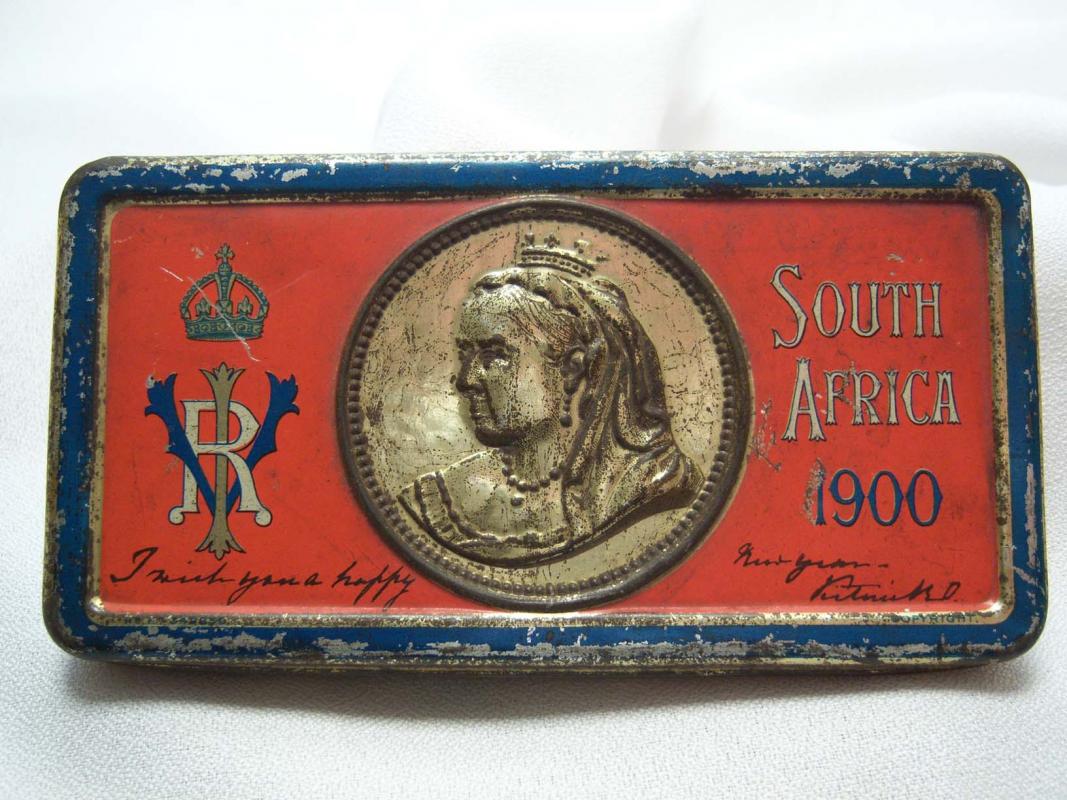
Two views of the letter, the first of the whole letter and then a closer view so that it can be read more easily.
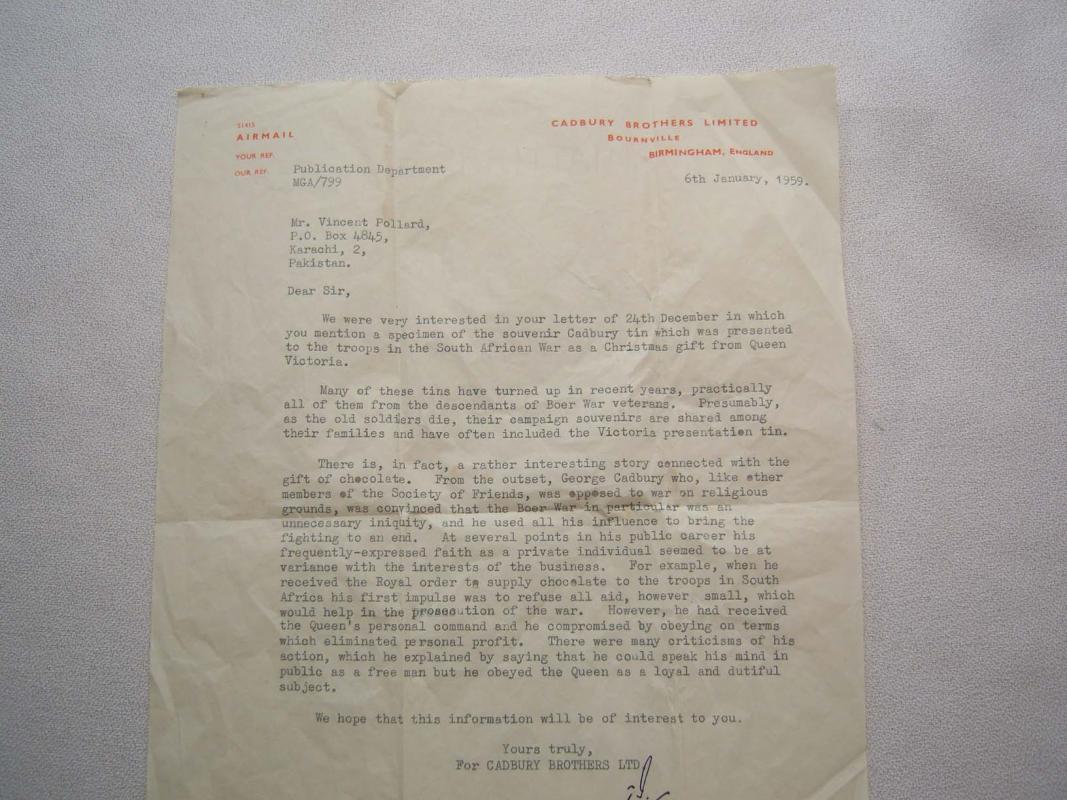

Regards
Brian
0 -
That is indeed a nice find, you're a lucky fellow.
Regards
Brian
0 -
I would have to agree with Chris regarding the manufacturing process would indicate an earlier specimen.
Ersatz cheap then...not so much so now, collecting-wise.
Regards
Brian
0 -
The Desert Rangers
Several years ago I purchased several Sitara-i-Harb 1965 known as the combat star for the Indo-Pakistan War of 1965. These were all named, as most of the 1965 stars are, and the regiment noted on the reverse was simply given as D.R. After doing as much searching as I could for the meaning of D.R. I contacted the members of another forum I belonged to at the time for assistance. There were some suggestions such as Dogra Regiment but these were all eliminated by other members leaving me no further along in discovering the regiments name. I suppose that is not a fair statement as in any research the elimination of possibilities can be an important part of the process and I do not want to diminish those members efforts, which were appreciated.
Not too long ago one of our fellow members and a long time friend, Ehjaz, made it possible for me to purchase a two medal Pakistan group consisting of the Sitara-i-Hard 1965 and accompanying Tamgha-i-Jang 1965 (the 1965 War Medal). The star was named to a member of the D.R. While the pair was a welcomed addition the best part was that Ehjaz had also answered my long standing question as to what D.R. stood for.
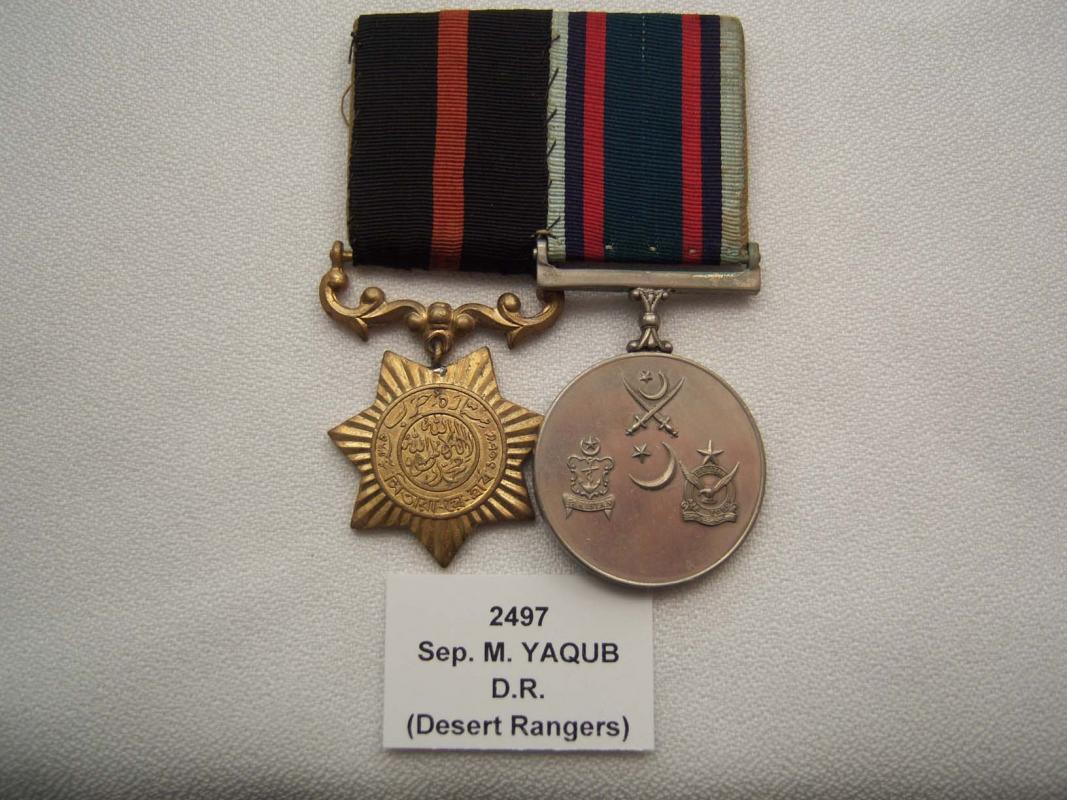
Pakistans Desert Rangers
In 1958 the West Pakistan Rangers (WPR) was formed. This group comprised of,
. Sutlej Rangers (Punjab Border Police) HQ: Lahore
. Desert Rangers (Bahawalpur Border Police) HQ: Bahawalpur
. Indus Rangers (Kharipur Military Police and Sindh Border Police) HQ:
Hyderabad
The WPR was changed to the Pakistan Rangers (Punjab) in 1972.
According to the Pakistan Army web page the roles of the Pakistan Ranger (Punjab) are as follows.
. Protection of persons and proper tint he border areas.
. Apprehension of persons unlawfully entering into Pakistan or going out of Pakistan territory.
. Prevention of smuggling.
. Provision of assistance to police to detect and prevent crime in the border area.
. Reinforcing police for the maintenance of law and order, primarily in the border area.
. Collection of intelligence and provision of early warning about smugglers movements /enemy concentrations.
. Be under command of the Army during war/escalation.
According to the web site the major responsibilities assigned to the Pakistan Ranger (Punjab) is to prevent smuggling. Gold, narcotics and drugs are smuggled from Pakistan and liquor and acetic anhydride are smuggled into Pakistan from India.
[Acetic anhydride is used in the synthesis of heroin by the diacetylation of morphine.]
The Rangers fought shoulder to shoulder with the Pakistan Army in the past two wars [against India in 1965 and 1971].
The Rangers suffered 168 dead and 66 wounded in the 1965 War and in 1971 causalities were 65 with 10 wounded.

Regards
Brian
0




Some attributed EK1s
in Germany: All Eras: The Iron Cross
Posted
Well done Chris.
Thanks for posting this.
Regards
Brian